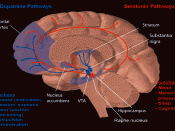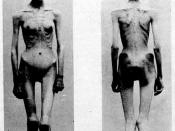Eating disorders are a serious problem, especially among women in today's world. This problem is often overlooked and under attended to by society, which I consider to be a major cause of them in the first place. Society desperately needs to become more informed and concerned with the eating disorder dilemma, and possibly make some changes to help.
Eating disorders can occur in anyone, but they are more prominent in females. When the words eating disorder are mentioned, most people think of desperate teens just trying to fit into society's mold. However, this disease not only affects teens, but adults as well.
There are many causes of these horrid and dangerous disorders, many of which are linked to problems or values of society. The major fault with society, today and in the past, is the major emphasis on weight and being thin. It is as if a woman's value is based on how thin she is, this is definitely not true.
Society in general has changed its values. The divorce rates are skyrocketing, making women feel that they must stay thin and "good-looking" to keep their families together. Society has also placed an emphasis on age, with youth being the value. The basic fear of getting old causes many people to want to stay thin. After all, "thin is beautiful" and that is something they can control.
Some causes are not linked to society but rather the person's emotional state. Society only helps them along with it's pressures. Emotional disturbance is almost always present in an eating disorder victim. The victim's emotional problems have a wide range, but many linked to early childhood, concerning family problems or abuse, especially sexual. Emotional and personal problems combined with society's rules is the main reason these eating disorders are around today.
When a person finally realizes they have an eating disorder, they can receive help. The treatment involves a process which includes two steps. They are (1) a change in eating habit and (2) healing the emotional problem (Dawson 136). During treatment people can learn to focus on things other than weight and their body and deal with their problems or stress that arrives in a more positive manner. As stated before, to get help that will last, the emotional as well as the physical problems must be dealt with. The Oklahoma City Center for Eating Disorders reported that the combination of intense group therapy and a strict weight loss plan is very successful ("Hunger in Soul" 5). Going through the therapy and dealing with the emotional problems is the hard part.
There are three major eating disorders that are prominent today. The following pages will discuss what the disease are, who has them, what causes them, and how they can be treated. Hopefully, this will help to inform and show the results of society's unrealistic expectations.
The first and most common eating disorder is compulsive eating. This eating is done in uncontrollable binges. Studies show that much as 2% of the population suffer from this disorderXXXXXXXXXnew stat⦠However, experts who treat these disorders claim that as high as 5 ý million women over thirty suffer from this disorder. Thirty percent of the people in medically supervised weight programs suffer this binge eating disorder ("Binge Eaters").
There are many causes of this compulsive overeating most of which are triggered by emotions. Compulsive overeaters are four times as likely to have suffered from depression than Bulimia or Anorexia patients (Binge Eaters 8). They also have a history of more panic disorders and personality disorders. Many of these people have a low self-esteem, or use the food to fill a void because they are lonely, or eat because of resentment of family (Dawson 134-136). Looking over many cases a conclusion that most of these people are not self-centered. Due to this fact it is believed that they eat to hide the anger they feel fro being used to taken advantage of (DAWSON 136).
Once a person realizes they are a compulsive eater they can correct the problem. For this disorder treatment usually just consists of finding support through organized support groups.
The second most frequently found eating disorder is Bulimia. This consists of eating more food than a normal person in the same amount of time and then purging to rid your body of the calories by vomiting, taking laxatives, enemas, diuretics, or exercising excessively. Most people who do this do not like their weight to their body shape, or have problems that are emotionally rooted. Usually people who are bulimic binge and purge at least 2 times a week for at least 3 months (When eating Becomesâ¦.C7). Few of the people who are Bulimic probably realize that they only reduce their calorie intake by 50% when they vomit (Goleman c7). Just as with any other disorder Bulimia doesn't just occur in young females. According to the American Anorexia and Bulimia Association 6% of women over thirty or about 4 million suffer from this disorder (Dawson 134). If a person is Bulimic for a period of time, the results are usually exhaustion, gastric and muscular pain, and if not treated eventually death.
Once the person realizes they are Bulimic they can seek treatment. After receiving good treatment 60%-70% get better (Goleman c7). Since most Bulimic patients experience depression treatment usually includes therapy combined with antidepressants. About 25%-45% of patients stop binging and purging after treatment with antidepressants (Goleman c7). One type of therapy that seems to be very effective is Cognitive - Behavioral Therapy, which has a success rate of up to 65 % (Goleman C7). This is a three step process including (1) establishing good eating habits, (2) "self - monitoring" -keeping a record of when you do it and why, and (3) changing their attitude toward their weight and body (Goleman C7). This is a combination of physical and emotional therapy, which seems to be the only real treatment.
The third and least common of the three eating disorders is anorexia. This is inadequate eating that results in not maintaining the proper weight. Usually the person with anorexia has a body weight that is 85% less than it is expected to be (When Eating Becomes C2). These people usually do not accept that they are underweight and still feel fat. When a woman is anorexic they begin to lose their female shape and their menstrual period. An anorexic will usually have missed at least 3 periods in a row due to low weight (When Eating Becomes C2). Also if not treated this disorder could result in death. Approximately 5%-8% of anorexics, over a 10 year period will die from either suicide or severe weight loss (Goleman c2). Although this disease is very common among young teens, studies show that it occurs in adults as well. According to the American Anorexic and Bulimia Association, 2% or more than 1 million women over thirty suffer from anorexia. This is a disorder that is very serious and occurs at all ages.
There are many reasons why people become anorexic, the main one being non-satisfaction with the body. According to the U.S. Health Department and Human Services, about 70% of normal women weight women want to lose weight and about 23% of underweight women want to as well (How this is 75). The other main causes are emptiness and a fear of intimacy (Dawson 134). Another reason for being anorexic is that society has thrown at us the waif-like models that appear on the cover of every magazine. These models encourage anorexia in teens who already are worried about heir weight (How Thin IS 74). The way these "waifs" are promoted backs up the emphasis that society has placed on women to be thin.
Anorexia can be treated, if a person seeks treatment before it kills them. This treatment usually comes from a doctor in a hospital environment, due to the health of a patient by the time they seek help (Dawson136).
As this paper has shown eating disorders are a serious problem that has been pushed aside. Society needs to realize that it is a problem that desperately needs their attention. People need to feel it is alright to be themselves, be that large or small, and not have to fit into that perfect little model that society has created for them.





